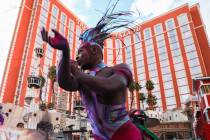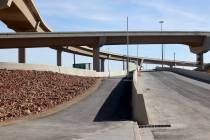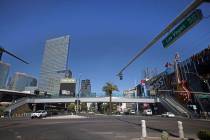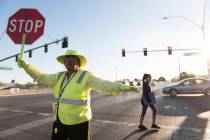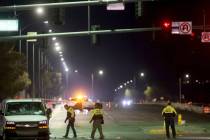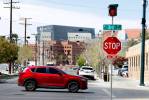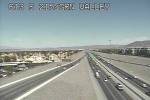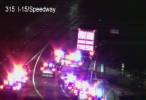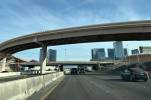Highway Patrol, police work to stop speeders
Left hand on the Department of Motor Vehicles driver's manual, right hand in the air: Do you swear to tell the truth, the whole truth and nothing but the truth, so help you Road Warrior?
Admit it, valley driver. You're guilty of zipping down the freeway faster than you should - 10, 15, even 20 mph over the speed limit - because you're running late or not paying attention or, to pull out that old standby, "I'm just keeping up with the flow of traffic."
That's when you see it.
The blue car off to the side of the road.
The one with the lights on top, which may be spinning brightly if a speeding motorist has been pulled over. Or not spinning if the Nevada Highway Patrol trooper inside is lying in wait for the next eventual lawbreaker.
Suddenly snapped to your senses, you slow down as you approach, making sure to check the speedometer so as not to exceed the limit as you pass. But once you have, as that blue car becomes a shrinking dot in your rearview mirror, you ease off the brake and put that lead foot back on the accelerator.
"I just passed one," you subconsciously tell yourself, "What are the chances there's another one nearby?"
Answer: Don't test your luck.
Beginning on Nov. 19, the Metropolitan Police Department returned to providing extended enforcement on freeways in an effort to reduce all traffic-related deaths - freeway and surface streets - which stand at 120 for the year in Clark County.
That blue Highway Patrol cruiser you just passed could be followed a mile or so down the road by a Las Vegas police black-and-white or a motorcycle from either agency. Heck, there could be as many as three law enforcement officers in any two-mile stretch.
"Our goal is zero fatalities, and freeway enforcement is one of those tactics now being used," explains Sgt. Todd Raybuck, spokesman for the Metropolitan Police Department's traffic bureau. "Traffic cops, patrol cops - they complement our friends with Highway Patrol in their activities.
"Most drivers will see a couple of enforcement officers in a row and they'll say, 'Holy smoke, I haven't seen that before,' or, 'I haven't seen that for a while.' The visual reminder will work for them. But for those who don't get the visual reminder, we'll give them a written reminder."
It was 2010 when Las Vegas police last joined the Highway Patrol in such a concerted endeavor. The police traffic bureau leader at the time, Capt. Richard Collins, found the combined enforcement helped reduce accidents - and fatalities - not just on the freeways but on nearby surface streets.
Collins, who now directs the department's downtown command, subscribes to the theory of "velocitation." It's the belief that drivers who speed for extended periods on freeways will speed shortly after leaving them because their minds have been lulled into a false sense that they're going slower than they really are - the responsibility of checking one's speedometer, notwithstanding.
Collins did a "geographical" study one year while he was in charge of traffic and found that 65 percent of all fatalities in the jurisdiction of Las Vegas police were within one mile of a freeway.
"There's no true empirical proof; this is just hypothesis," he says. "But when you're dealing with the freeway system, and you have the majority of your fatal accidents occurring within a mile of them, it would be safe to say that a portion of them had to do with people coming off the freeway, and probably the speed they were driving."
Excessive speed, that is. Which is why Collins passes on using the obscure term velocitation these days in favor of a cautionary phrase better understood by the public: "Drive fast on the freeway; drive fast on the surface street."
So today we again have Las Vegas police joining the Highway Patrol in an effort to pull the weed out by its roots. Slow the heavy-footed drivers on the freeways and hopefully they'll be slower on surface streets.
"The intent, with any increased presence, is to deter violations whether they occur on the freeways or surface streets," Loy Hixson, a Highway Patrol spokesman, said of the shared presence.
He added that Las Vegas police aren't answering typical Highway Patrol-related calls.
"For most of us, our days start with driving on the freeways," police spokesman Raybuck says. "If we can make an impression at the start of the day with enhanced freeway enforcement, maybe we can set the pace for drivers for the rest of their day."
That's not to say there isn't shared enforcement during other times of the day, including the evening rush hour. Raybuck also says there's no timetable for how long city police will assist with freeway enforcement, but it's apparent they're looking for results, not public perception.
"We've learned over time that we have to do more than just write speeding tickets. We have to get people to change their driving tactics," Raybuck says. "What I tell people is that it starts with me, with my family, with my neighbors.
"If increased freeway enforcement is creating a conversation, we're getting close to our goal of zero fatalities."
While reaching that goal is highly unlikely, it's still an important, well-intended mission that starts with all of us swearing to ease up on the accelerator - so help us Road Warrior.
Questions and comments should be sent to roadwarrior@reviewjournal.com. Please include your phone number. Follow the Road Warrior on Twitter: @RJroadwarrior.
Sunday, Dec. 2
Street closings for Rock 'N' Roll Las Vegas Marathon
■ Lane restrictions at Las Vegas Boulevard and Flamingo Road, from 2 a.m. to 10 a.m. today through Tuesday for a manhole rehabilitation project.
■ Lane restrictions on southbound Decatur Boulevard, between Cheyenne Avenue and Lone Mountain Road, through Friday for roadway improvements.
■ Lane restrictions near Nellis Boulevard and Desert Inn Road through Friday for sewer rehabilitation project.
■ Closure of Buffalo Drive, between Russell Road and Patrick Lane, through Dec. 24 for construction of enclosed flood-control channel.
■ Closure of Ogden Avenue, between Las Vegas Boulevard and 11th Street, and part of Eighth Street, between Fremont Street and Ogden, through Jan. 11 for roadway improvements.
■ Detour of eastbound traffic on Sahara Avenue at Boulder Highway through March for a storm drain construction project.
■ Delays on Jones Boulevard from U.S. Highway 95 to Sahara Avenue for widening.
■ ■ ■
Following are lane restrictions resulting from Water Reclamation District surveys:
■ Wigwam Avenue at Las Vegas Boulevard through Dec. 31.
■ Valley View Boulevard, north of Ford Avenue, through Dec. 31.
■ Valley View Boulevard, north of Pebble Road, through Dec. 31.
GASOLINE PRICES
The average price of gasoline Friday in the Las Vegas Valley was $3.48 per gallon; the state average was $3.50; the national average was $3.41.
LAS VEGAS REVIEW-JOURNAL










